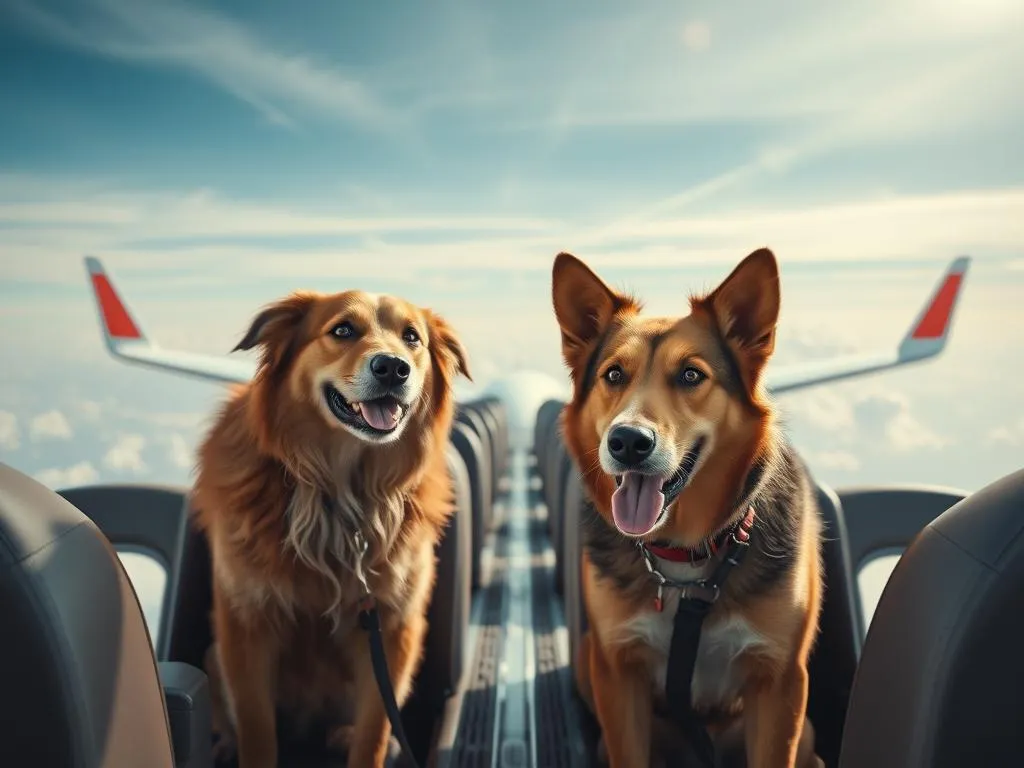
Traveling with pets has become increasingly popular as more pet owners view their furry friends as part of the family. Understanding airline policies regarding pet travel is crucial to ensure a smooth journey for both you and your dog. So, where do dogs go on planes? This article will explore the various options available for flying with your dog, the preparations you need to make, what to expect at the airport, and how to help your pup adjust to their new environment once you arrive at your destination.
Understanding Airline Policies for Pet Travel
Different Types of Travel Classifications
When it comes to air travel with dogs, the two primary classifications are in-cabin travel and cargo travel.
-
In-Cabin Travel: This option allows small dogs to fly with you in the passenger cabin, typically under the seat in front of you. Most airlines have size and weight restrictions for in-cabin pets, often limiting them to around 15-20 pounds including the carrier.
-
Cargo Travel: Larger dogs that exceed the size limit for in-cabin travel may need to fly in the cargo hold. This area is temperature-controlled, but it can still be a concerning experience for pet owners.
Major Airlines’ Pet Policies
Each airline has its own pet travel policies. Here’s a brief overview of the policies of major US airlines:
-
American Airlines: Allows in-cabin pets up to 20 pounds and cargo travel for larger dogs. Fees range from $125 for in-cabin to $200 for cargo.
-
Delta Airlines: Similar in terms of weight restrictions, Delta charges $125 for in-cabin pets and $200 for cargo travel.
-
Southwest Airlines: Only allows in-cabin travel for dogs up to 20 pounds, charging a fee of $95.
-
United Airlines: Offers both in-cabin and cargo options, with fees varying from $125 for in-cabin to $200 or more for cargo, depending on the route.
It’s essential to compare costs, sizes, and types of pets allowed for each airline, as policies can vary significantly.
Documentation and Requirements
Before traveling, ensure you have all necessary documentation:
-
Health Certificates and Vaccination Records: Most airlines require a recent health certificate from your vet, often issued within 10 days of travel. Vaccination records should be up-to-date, especially for rabies.
-
Identification Tags and Microchipping: Always have a collar with an ID tag on your dog, and consider microchipping for an additional layer of security.
-
Additional Paperwork: Some airlines may require specific forms or declarations, particularly for international travel. Check with your airline for detailed requirements.
Preparing Your Dog for Air Travel
Choosing the Right Carrier
Selecting the right carrier is crucial for your dog’s safety and comfort during the flight:
-
Size and Comfort Considerations: The carrier should be spacious enough for your dog to stand, turn around, and lie down comfortably. Measure your dog before purchasing a carrier.
-
Airline-Approved Carriers: Ensure that the carrier meets airline specifications, which can include specific dimensions and ventilation requirements.
Training Your Dog for Travel
Acclimating your dog to the carrier can help reduce anxiety:
-
Acclimatizing Your Dog: Start by introducing your dog to the carrier at home. Leave it open with treats inside to encourage exploration.
-
Practice Runs: Take your dog on short car trips in the carrier to simulate the travel experience. Gradually increase the duration to help them adjust.
Health Considerations
Prior to flying, consider your dog’s health:
-
Vet Check-Ups: Schedule a visit to your vet to ensure your dog is healthy enough to travel. Discuss any concerns you may have.
-
Medication for Anxiety or Motion Sickness: If your dog is prone to anxiety or motion sickness, consult your vet about appropriate medications.
-
Nutritional Needs: Maintain your dog’s regular feeding schedule as much as possible. Avoid feeding them right before the flight to reduce the risk of nausea.
What to Expect at the Airport
Arriving at the Airport
Timing is crucial when traveling with pets:
-
Recommended Arrival Time: Arrive at least two hours before domestic flights to allow ample time for check-in and security procedures.
-
Check-In Processes for Pets: Some airlines require you to check in your pet at a designated area. Make sure to have all documentation ready.
Security Procedures for Pets
Passing through security can be a bit different for pet travelers:
-
What to Expect During TSA Screenings: You will likely need to remove your dog from the carrier for screening. Be prepared to walk them through a metal detector while the carrier goes through the X-ray machine.
-
Tips for Easing Your Dog’s Anxiety: Use a leash to keep your dog close and calm. Speak soothingly to them, and have treats handy to reward good behavior.
Waiting Areas and Amenities
Airports are becoming more pet-friendly:
-
Pet Relief Areas: Many major airports have designated areas for pets to relieve themselves. Look for these areas upon arrival.
-
Keeping Your Dog Calm While Waiting: Bring familiar items like their favorite blanket or toy to help ease anxiety. A calm environment before the flight can make a significant difference.
During the Flight: What Happens to Dogs?
In-Cabin Experience
For those flying in the cabin, here’s what to expect:
-
Where Dogs Are Placed: In-cabin dogs typically remain in their carriers under the seat in front of you.
-
Comfort Tips for Long Flights: Consider bringing a small blanket or familiar item to provide comfort. Ensure your dog has access to water before the flight.
Cargo Experience
If your dog is traveling in cargo, understanding the environment is essential:
-
Description of the Cargo Hold Environment: Cargo holds are pressurized and temperature-controlled, but they can be noisier and darker than the cabin.
-
Ensuring Safety and Comfort: Use a sturdy, well-ventilated carrier. Clearly label the carrier with your contact information and any special instructions.
Dealing with Emergencies
Emergencies can happen, so it’s good to be prepared:
-
What to Do in Case of an Emergency: If your dog shows signs of distress, notify the flight attendants immediately. Most airlines have protocols for handling pet emergencies.
-
Airline Protocols: Familiarize yourself with your airline’s specific emergency procedures to ensure quick action if needed.
Arrival at Destination
Reuniting with Your Dog
After the flight, the reunion can be emotional:
-
Retrieving Your Dog: If traveling in-cabin, you’ll have your dog with you upon landing. If your dog traveled in cargo, head to the designated area to pick them up.
-
Checking Your Dog’s Condition: Upon reunion, inspect your dog for any signs of stress or discomfort. Offer them water and a chance to relieve themselves.
Adjusting to the New Environment
Once you arrive, help your dog settle in:
-
How to Help Your Dog Acclimate: Introduce them to the new surroundings gradually. Allow them to explore while keeping a close eye on them.
-
Maintaining Routines: Stick to your dog’s regular feeding and exercise schedule as much as possible to provide stability.
Local Regulations and Pet-Friendly Locations
Researching the local area is essential for pet owners:
-
Pet Regulations: Check local laws regarding leash laws, breed restrictions, and pet-friendly spaces.
-
Pet-Friendly Accommodations: Use resources like pet travel websites to find hotels, parks, and activities that welcome pets. Planning ahead can enhance your travel experience.
Conclusion
Traveling with your dog requires careful planning, but the rewards of sharing new experiences with your furry friend are immeasurable. From understanding airline policies and preparing your dog for travel to navigating the airport and adjusting to a new environment, each step is crucial for a successful journey. Remember, thorough preparation is key to ensuring a safe and enjoyable experience for both you and your pet. As you embark on your next adventure, consider sharing your own tips and experiences with fellow pet travelers. Happy travels!









